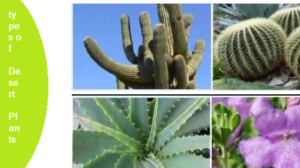
What is a desert Plants?
Desert plants thrive in hot, arid environments where they can survive with minimal rainfall. The desert biome is characterized by sandy or stony soil, high temperatures, and little moisture. Plants that grow well in desert environments need to store moisture in their fleshy leaves or have an extensive root system. Cacti are the most common desert plants; however, succulents, desert trees, grasses, and types of small shrubs and flowering bushes all grow well in deserts.
Types of Desert Plants?
Common plants that survive desert climates are species of cacti such as the prickly pear, barrel cactus, or organ pipe cactus. Popular flowering desert plants and shrubs are the desert lily, California poppy, and aloe vera plants. For shade in a Southwest desert landscape, you can grow the desert willow or species of acacia trees.
In general, plants that grow best in the desert flora should be the following:
- Full-sun plants that don’t need any shade.
- Drought tolerant plants, shrubs, and trees that survive without water.
- Plants that grow well in sandy, arid soil.
- Cacti, succulents, shrubs, and trees that tolerate hot temperatures during the day and cold at night.
This article has a list of some of the most common plants that grow in the desert biome. Along with descriptions of these popular desert plants, pictures and their scientific names will help identify the best ones to grow in your yard.
Prickly Pear Cactus (Opuntia)
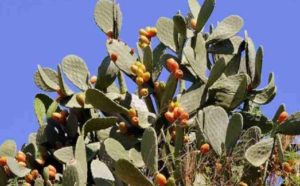
An iconic desert cactus is the prickly pear with green, pad-like succulent leaves that are covered in spines. These are some of the most common desert plants found in the Southwestern United States. The thick, fleshy leaves store a lot of moisture, which helps the plant survive the desert ecosystem.
The prickly pear cactus also flowers in deserts when conditions are right. The yellow, purple, and red showy flowers help to give color in barren, arid landscapes. These large desert cacti can grow to between 16 and 23 ft. (5 – 7 m) and look similar to rabbit ears cactus.
The Joshua Tree (Yucca brevifolia)
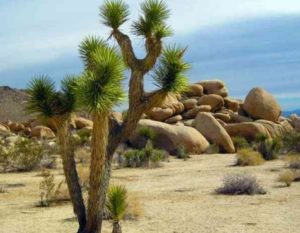
The Joshua tree is a type of yucca plant that grows in the Mojave Desert. This drought-tolerant tree-like desert plant also has names such as yucca palm and palm tree yucca. Native to Arizona, Utah, California, and Nevada, the large sun-loving plant can grow as high as 50 ft. (15 m). The slow-growing tree may take many years to reach that height.
The large desert Joshua tree gets its moisture from the arid landscape by a large root system. The short, stumpy branches have spiky green leaves. These leaves grow in clumps at the end of the thick branches, giving the Joshua tree a barren appearance.
Golden Barrel Cactus (Echinocactus grusonii)
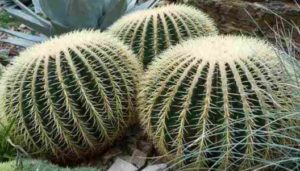
The golden barrel cactus looks like a large spherical spiked globe. The round green cactus has yellow or white sharp spines, and the plant produces a crown of small yellow flowers. These hardy desert plants are a great addition to rock gardens or desert landscapes in full sun and hot, arid conditions.
Golden barrel cacti are slow growers that can live for up to 30 years. The globular, low-growing plant may eventually reach 3 ft. (1 m) in height. These cacti are rare in deserts due to habitat destruction; however, they are excellent specimen plants growing in yards. You can plant them in sandy, well-draining soil in your yard or grow in pots.
Curve Leaf Yucca (Yucca gloriosa var. tristis)
Yucca plants are commonly found in many deserts, and they withstand hot sun and little water. This yucca variety is commonly grown as an ornamental plant in the southern U.S. states. This desert plant has lower leaves that curved backward and upper leaves that are long and stiff, which taper to a sharp point.
Like most plants that thrive in desert climates, this yucca variety grows in sandy soil and coastal dunes. The thick trunk grows to about 4 or 5 ft. (1.2 – 1.5 m) high. Yucca desert plants also bloom with large clusters of white fragrant flowers.
Saguaro Cactus (Carnegiea gigantea)
As the scientific name of this desert plant suggests, this is a huge cactus. Pictures of desert terrain often show this tall cactus with its large arm-like branches curving upward. The thick columnar stem stores moisture that allows this plant to survive the driest of conditions. These common desert plants found in the hot, barren landscapes of the southwest states and northern Mexico.
The saguaro cactus is the largest of any cactus to grow in the desert biome. These flowering plants also bloom in the desert between April and June. Large white trumpet-like flowers attract pollinators such as honeybees and hummingbirds. Although these cacti grow up to 52 ft. (16 m), they are slow-growing plants. So, if you want to create a desert landscape in your yard, a saguaro cactus is an excellent choice.
Organ Pipe Cactus (Stenocereus thurberi)
The organ pipe cactus lives up to its name because of the long tubular succulent stems that look like a pipe organ. These common desert plants grow up to 16 ft. (5 m) and the thick-ribbed stems are covered in sharp spines. Desert dwellers prized these plants due to their large tasty fruits. Some say that the delicious fruits from this plant taste better than watermelon.
These drought-tolerant plants grow well in gardens that get full sun and little shade. As with most succulent and cacti, plant them in well-draining, sandy soil. In their native habitat, the cacti are found in Arizona and Mexico in the Sonoran Desert.
Brittlebush (Encelia farinosa)
Brittlebush is one of the most common desert shrubs in the southern states and Mexico. As its common name suggests, the brittlebush has stems that are stiff and easily break. This low-growing shrub helps brighten up desert landscape when it flowers. Yellow flowers bloom in the small clumps of dry foliage. During dry seasons, the bushy plant loses its leaves and relies on moisture stored in its stems to survive hot desert climates.
Creosote Bush (Larrea tridentata)
This desert plant is also named greasewood, and it’s a flowering species of hardy plant native to arid deserts. The evergreen shrub produces dainty yellow flowers, and its large root system absorbs moisture from deep in the desert soil. This bushy desert plant gets its common name because it smells of creosote compounds distilled from coal tar.
Mature creosote bush plants can survive temperatures up to 160°F (70°C) and extreme drought.
Ghost Plant (Graptopetalum paraguayense)

The ghost plant is a type of succulent that grows in various habitats, including the hot, dry conditions of a desert climate. Some of the other common names of this desert plant include mother-of-pearl plant and sedum weinbergii. This ground-covering plant is native to Mexico. The succulent leaves grow in a rosette form, and the plant is also called the porcelain succulent.
These desert plants also look gorgeous as a small houseplant, in a rock garden, or an open terrarium.
Red Pancake (Kalanchoe thyrsiflora)
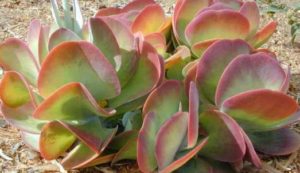
The common names for this small desert-dwelling plant mostly describe the leaves of this succulent—red pancake, paddle plant, desert cabbage, and flapjacks. The large, round, fleshy leaves are a blue-green color with hints of red blushing on the edges. The desert succulent produces yellow waxy flowers.
In a full-sun garden, these low-water desert plants don’t require much maintenance. The hot sun helps the leaves keep their color, and the fleshy leaves hold moisture.
Fox Tail Agave (Agave attenuata)
Fox tail agave thrives in hot arid climates of deserts in the southwest. Pictures of these desert plants would seem to suggest that they belong to the family Aloe. However, these large desert plants are from a different family.
The fox tail agave is one of the most popular agave plants for desert gardens. The clump of thick bluish-green leaves gives the large plant a spiky appearance. These succulent leaves are packed with moisture to help them endure dry desert terrain. Fox tail agave plants are popular ornamental garden plants in arid as well as subtropical climates.
Mexican Feather Grass (Stipa tenuissima)
Mexican feather grass is an ornamental grass that thrives in full sun and can survive desert drought. Other common names for this hardy desert plant are Mexican feathergrass, fine-leaved nassella, and fine-stem needlegrass. The wispy, delicate blades of grass can help enhance the appearance of an attractive rock garden or desert landscape.
Tumbleweed
Pictures of tumbleweed blowing across deserted desert roads is a classic image of movies of the Wild West. Tumbleweeds form from many different types of desert plants. The ball of light dry weed is the whole plant when it detaches from the root system. Its other common name is Russian thistle, indicating that it’s native to Russia as well as the western United States.
As the plant gets blown through the barren desert landscape, it disperses seeds that help this invasive plant to reproduce.
Desert Marigold (Baileya)
Desert marigolds are perennial plants found in the deserts of Mexico, Utah, California, and Arizona. The flowering plants add a splash of yellow color in an arid, barren desert. The large disc flowers bloom from spring and right through the hottest months of the year.
These sun-loving desert plants are an excellent choice of plant if you live in a desert climate. With little maintenance, you can get beautiful yellow flowers throughout hot summers.
Desert Lily (Hesperocallis)
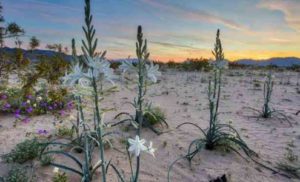
It’s not just cacti and succulents that can survive hot desert weather. The desert lily is a common desert plant in the Southwest and Mexico. The family name reveals this heat-tolerant plant is not a true lily but it’s more related to agave plants. However, the bluish-gray plant produces large white lily-like flowers—hence the common name desert lily.
These large plants that live only in the desert can grow up to 6 ft. (1.8 m) tall.
Jumping Cholla (Cylindropuntia fulgida)
The jumping cholla is a tree-like plant commonly found in the Sonora desert of Arizona and parts of California. This desert-loving plant is like a cross between a tree and a cactus. The plant has a thick trunk with branches that grow at the top. These branches are covered with barbs that can be painful if they catch on your skin.
The jumping cholla desert tree grows to about 13 ft. (4 m) high and produces pink and white flowers with lavender-colored markings.
Ocotillo (Fouquieria splendens)
Ocotillo is a common name for a type of desert cactus with long, tall green stems. Other names for this plant include vine cactus, desert coral, slim wood, and candlewood. The cacti are common plants found in states such as Arizona, Texas, New Mexico, and California.
When it rains in the desert, this plant undergoes a transformation. The dry, barren stems become plump with moisture, lush leaves appear, and bright crimson flowers bloom.
Yellow Paloverde (Parkinsonia microphylla)
The yellow paloverde is a large desert tree and is one of the most common trees native to the Sonoran Desert. This species of palo verde tree usually grows to around 16 ft. (5 m) and has yellowish-green foliage. The yellow paloverde is a deciduous tree that loses its leaves in hot, dry seasons.
This tree can endure the harsh desert conditions because its green bark carries out photosynthesis. As with many desert plants, flowers appear after rainfall.
Mojave Aster (Xylorhiza tortifolia)
One of the most stunning flowering desert plants is the Mojave aster—also called the Mojave woody aster. Native to the Mojave Desert, hence the common name, the plant produces large flowers similar to daisies. The petals look like lavender and white rays emitting from a yellow center.
These delightful flowers are also found in the Sonoran Desert and Great Basin Desert. It’s commonly found alongside other desert plants such as Joshua trees, creosote bushes, and saltbush scrubs.
Jade Plant (Crassula ovata)
Jade plants—also called money trees—are easy-to-care-for houseplants that grow outdoors in desert environments. Their tolerance for arid conditions is the reason why these plants hardly require watering indoors. Jade plants are small shrubs that can also look like miniature trees. Although these plants can grow in the shade, they need plenty of sunshine to help them thrive.
Growing indoors, people put these potted plants in auspicious places as they are said to be plants that bring good luck.
Yellow Bells (Tecoma stans)
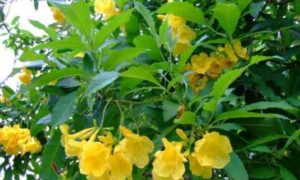
Yellow bells or yellow trumpetbush is a flowering desert shrub that is drought and heat tolerant. As its name suggests, the yellow bells plant produces brightly-colored golden-yellow flowers in the shape of a funnel. The emerald green foliage turns into a mass of yellow color. This is an excellent shrub for desert landscaping if you need a full-sun flowering ornamental plant.
Desert Palm Trees
Pictures of desert palms gracing beaches are classic images of tropical beaches. However, many palms are suitable for dry, arid conditions of Arizona and other southwestern states. When choosing the right type of palms for a desert climate, it’s essential to consider sun exposure, humidity, and nighttime temperatures.
Here is a list of a few suitable desert palms for hot and dry climates:
- Acrocomia species—Grows well in arid habitats as long as there is no cold.
- Bismarck palm tree (Bismarckia nobilis)—Has an impressive display of silvery blue leaves in a fan shape.
- Cuban paddle palm tree (Copernicia baileyana)—This desert palm tree grows in hot, dry climates and tolerates the cold well.
- Ravenea xerophila—A slow-growing palm that grows well in the full, hot sun and has good drought tolerance.
Aloe Vera (Aloe barbadensis)
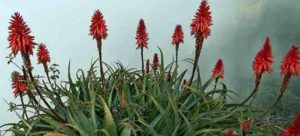
Aloe vera is a species of succulent plant that thrives in hot, arid climates. Pictures of aloe vera growing in deserts show these fleshy-leafed plants growing in bone-dry, sandy soil surrounded by rocks. There are over 500 species of aloe, with aloe vera being one of the most common. Most types of aloe plants grow in a rosette shape. You can also grow aloe vera indoors in pots.